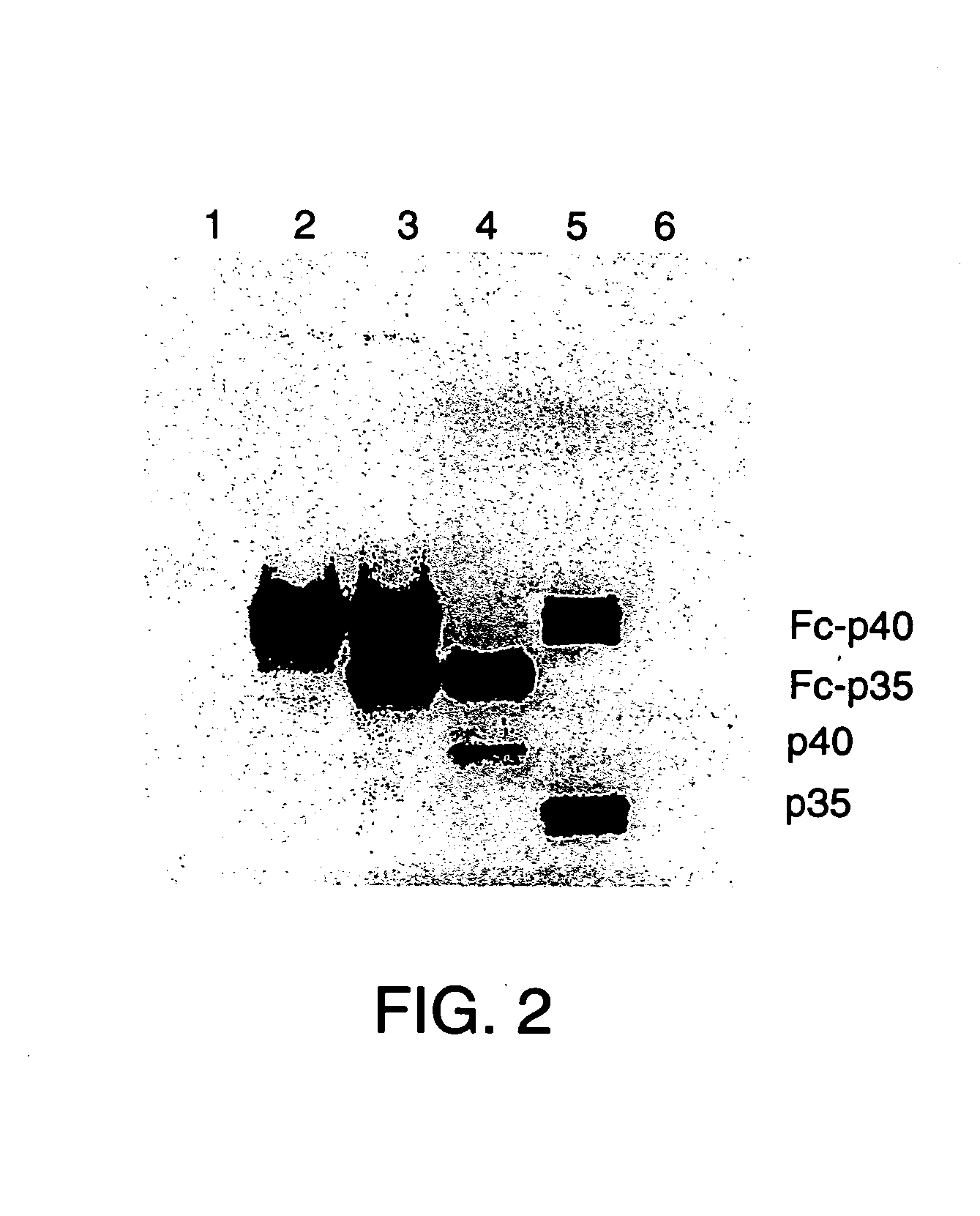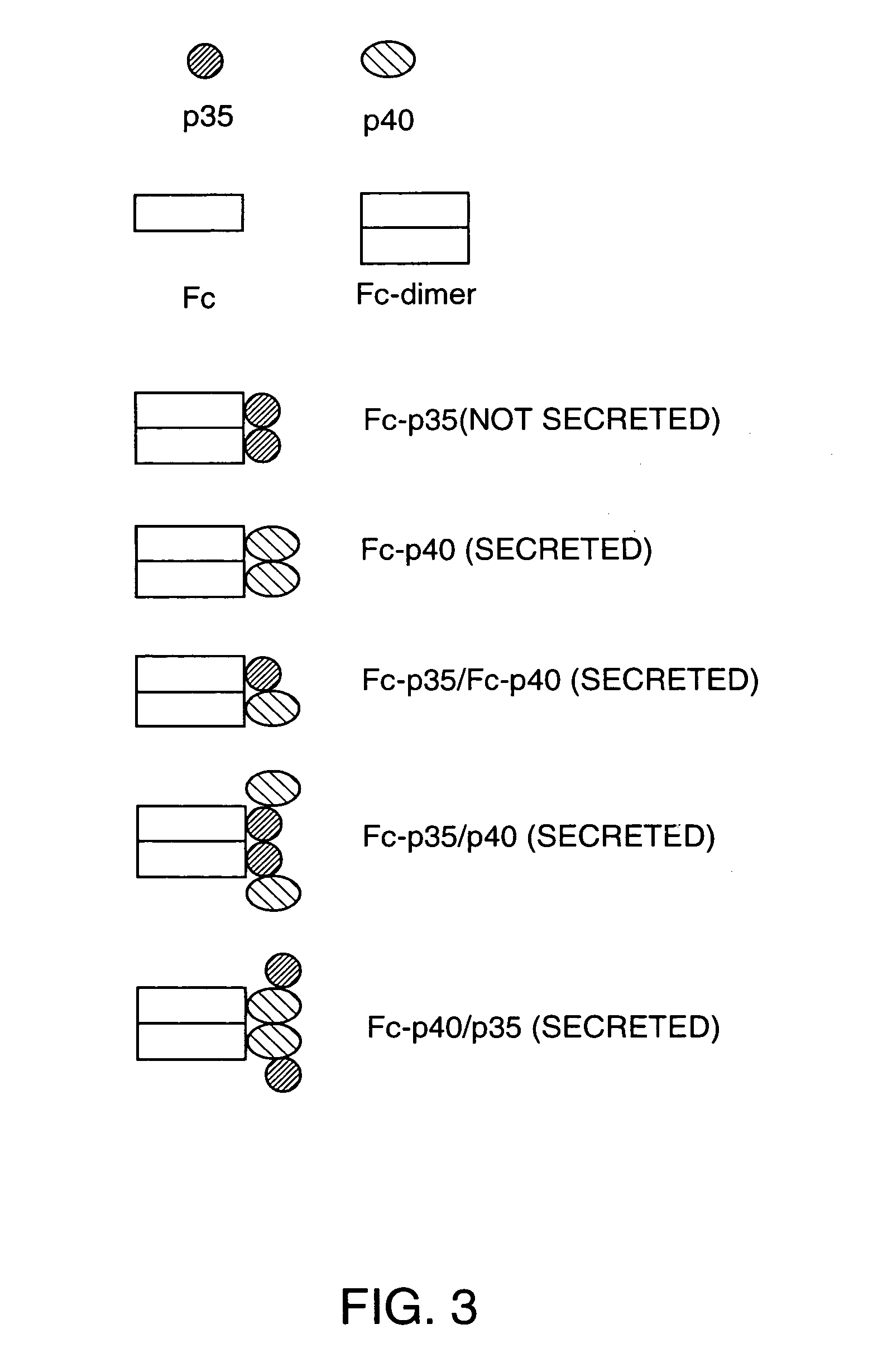Heterodimeric fusion proteins useful for targeted immune therapy and general immune stimulation
- Summary
- Abstract
- Description
- Claims
- Application Information
AI Technical Summary
Benefits of technology
Problems solved by technology
Method used
Image
Examples
example 1
Cloning cDNAs Encoding Human and Mouse IL-12 Subunits
[0040] Human peripheral blood monocytes (PBMC) were obtained from a healthy volunteer and were purified by centrifugation on a Ficoll-Hypaque (Pharmacia) gradient (1700 rpm for 20 min). The “buffy” coat containing the PBMC was diluted with serum-free culture medium (SF-RPMI) to a volume of 50 ml and collected by centrifugation at 1500 rpm for 5 min. Cells were resuspended in AIM-V cell culture medium (GIBCO) at a density of 5×106 cells / ml and were cultured for 2 days at 37° C. in a humidified CO2 incubator. The attached cells were selected by gently agitating the culture flask to remove non-adherent cells. Fresh medium containing phorbol ester (100 nM) and the calcium ionophore, ionomycin (0.1 μg / ml) was added. After three days, the cells were collected by gentle scraping and centrifugation. Poly A+ mRNA was prepared using oligo dT-coated beads (Dynal, Inc.).
[0041] Subunit cDNAs were cloned using polymerase chain reactions (PCR)...
example 2
Expression of Fusion Protein Combinations in Transfected Mammalian Cells
[0042] In order to make the fused versions of each subunit, the DNAs encoding the mature protein sequence of each were adapted as follows. The p40 subunit DNA was digested with NdeI which cuts very close to the junction of the mature protein and leader sequence, and XhoI. An adapter oligonucleotide was synthesized with the sequence 5′-CCGGGCAAGTCCA-3′ (SEQ ID NO: 7) hybridized to a second, partly complementary oligonucleotide with the sequence 5′-TATGGACTTGC-3′ (SEQ ID NO: 8). The double stranded DNA contains overhanging sequence compatible with ligation to an XmaI site at the 5′ end and an NdeI site at the 3′ end. This fragment was ligated to the NdeI-XhoI fragment of the p40 cDNA and cloned as an XmaI to XhoI fragment in vector pdC-Fc-X, cut with XmaI and XhoI. This vector already contains a human IgG1 Fc encoding DNA fragment in its genomic configuration (containing introns and exons) and fused downstream of...
example 3
Activity of Fusion Proteins on in an IFN-γInduction Assay
[0047] Biological activity was measured in an IFN-γ induction assay using mitogen-activated human PBMC, purified as described in Example 1. After gradient centrifugation, cells were resuspended in cell culture medium containing 10% fetal bovine serum (RPMI-10) and phytohemaglutinin (PHA; 10 μg / ml) at a density of 5×106 cells / ml and were cultured for 3 days at 37° C. in a humidified CO2 incubator. The PHA-activated cells were collected by centrifugation, washed three times with an equal volume of SF-RPMI and resuspended in fresh RPMI-10 (1×106 cells / ml). Aliquots (100 μl) were dispensed into the wells of multiple 96-well plates to give a final cell number of 105 per well. Test samples from culture medium were serially diluted in fresh culture medium and added to wells of the 96-well plate. Stimulation medium (50 μl / well) containing 10% serum and IL-2 (25 U / ml) was added. Control wells received only IL-2 (negative control) or b...
PUM
 Login to View More
Login to View More Abstract
Description
Claims
Application Information
 Login to View More
Login to View More - R&D
- Intellectual Property
- Life Sciences
- Materials
- Tech Scout
- Unparalleled Data Quality
- Higher Quality Content
- 60% Fewer Hallucinations
Browse by: Latest US Patents, China's latest patents, Technical Efficacy Thesaurus, Application Domain, Technology Topic, Popular Technical Reports.
© 2025 PatSnap. All rights reserved.Legal|Privacy policy|Modern Slavery Act Transparency Statement|Sitemap|About US| Contact US: help@patsnap.com



